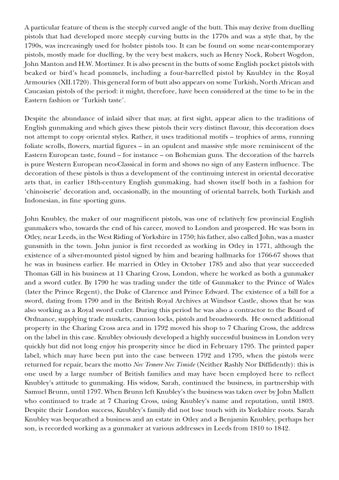103-198_25
17/9/05
1:23 pm
Page 186
A particular feature of them is the steeply curved angle of the butt. This may derive from duelling pistols that had developed more steeply curving butts in the 1770s and was a style that, by the 1790s, was increasingly used for holster pistols too. It can be found on some near-contemporary pistols, mostly made for duelling, by the very best makers, such as Henry Nock, Robert Wogdon, John Manton and H.W. Mortimer. It is also present in the butts of some English pocket pistols with beaked or bird’s head pommels, including a four-barrelled pistol by Knubley in the Royal Armouries (XII.1720). This general form of butt also appears on some Turkish, North African and Caucasian pistols of the period: it might, therefore, have been considered at the time to be in the Eastern fashion or ‘Turkish taste’. Despite the abundance of inlaid silver that may, at first sight, appear alien to the traditions of English gunmaking and which gives these pistols their very distinct flavour, this decoration does not attempt to copy oriental styles. Rather, it uses traditional motifs – trophies of arms, running foliate scrolls, flowers, martial figures – in an opulent and massive style more reminiscent of the Eastern European taste, found – for instance – on Bohemian guns. The decoration of the barrels is pure Western European neo-Classical in form and shows no sign of any Eastern influence. The decoration of these pistols is thus a development of the continuing interest in oriental decorative arts that, in earlier 18th-century English gunmaking, had shown itself both in a fashion for ‘chinoiserie’ decoration and, occasionally, in the mounting of oriental barrels, both Turkish and Indonesian, in fine sporting guns. John Knubley, the maker of our magnificent pistols, was one of relatively few provincial English gunmakers who, towards the end of his career, moved to London and prospered. He was born in Otley, near Leeds, in the West Riding of Yorkshire in 1750; his father, also called John, was a master gunsmith in the town. John junior is first recorded as working in Otley in 1771, although the existence of a silver-mounted pistol signed by him and bearing hallmarks for 1766-67 shows that he was in business earlier. He married in Otley in October 1785 and also that year succeeded Thomas Gill in his business at 11 Charing Cross, London, where he worked as both a gunmaker and a sword cutler. By 1790 he was trading under the title of Gunmaker to the Prince of Wales (later the Prince Regent), the Duke of Clarence and Prince Edward. The existence of a bill for a sword, dating from 1790 and in the British Royal Archives at Windsor Castle, shows that he was also working as a Royal sword cutler. During this period he was also a contractor to the Board of Ordnance, supplying trade muskets, cannon locks, pistols and broadswords. He owned additional property in the Charing Cross area and in 1792 moved his shop to 7 Charing Cross, the address on the label in this case. Knubley obviously developed a highly successful business in London very quickly but did not long enjoy his prosperity since he died in February 1795. The printed paper label, which may have been put into the case between 1792 and 1795, when the pistols were returned for repair, bears the motto Nec Temere Nec Timide (Neither Rashly Nor Diffidently): this is one used by a large number of British families and may have been employed here to reflect Knubley’s attitude to gunmaking. His widow, Sarah, continued the business, in partnership with Samuel Brunn, until 1797. When Brunn left Knubley’s the business was taken over by John Mallett who continued to trade at 7 Charing Cross, using Knubley’s name and reputation, until 1803. Despite their London success, Knubley’s family did not lose touch with its Yorkshire roots. Sarah Knubley was bequeathed a business and an estate in Otley and a Benjamin Knubley, perhaps her son, is recorded working as a gunmaker at various addresses in Leeds from 1810 to 1842.
